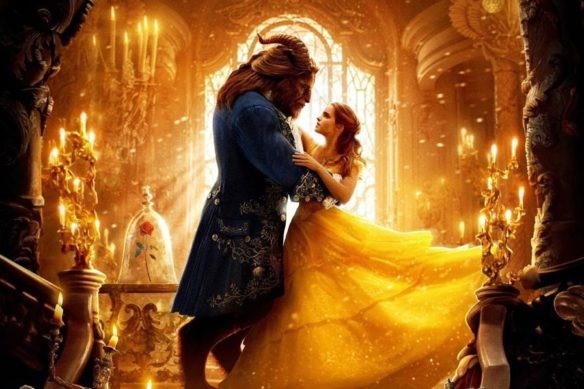 Following on Disney’s 2015 live-action Cinderella, we now have a live-action version of Beauty and the Beast, which opened on March 17, 2017.
Following on Disney’s 2015 live-action Cinderella, we now have a live-action version of Beauty and the Beast, which opened on March 17, 2017.
For those who are not familiar with Disney’s treatment of the story, it is worthwhile seeing the animated version before seeing the live-action film. While the live-action film is not slavishly faithful to the earlier animated film, it is fun to see how certain iconic scenes were rendered with real people. Alternately, one can review the details of the original story, though this could lead to dissatisfaction with the way the story has changed for our modern time. [spoilers]
I would also recommend that you look up who portrays each of the different actors in this version, particularly the many who are not seen in human form for the bulk of the movie. Those familiar with BBC productions will recognize the Beast as Dan Stevens, who realized the role of Matthew Crawley in Downton Abbey and the enchantress as Hattie Morahan, who realized the role of Elinor Dashwood in Andrew Davies’s 2008 adaptation of Sense and Sensibility. The rest of the cast needs little introduction, but I do wish I’d realized Emma Thompson was voicing Mrs. Potts. I was so wrapped up in missing Angela Lansbury’s cover of that role that I didn’t take the time to appreciate how Emma did it. So now I’ll just have to go back and watch the film again…
As was done in the 2015 Cinderella, the absence of the mother of our heroine is explained. In a nod to the original French story, the mirror is used to transport Belle (and the Beast) to a location of her choosing. They are whisked to the garret in Paris where Belle was apparently born. There we learn that Belle’s mother had died of plague. It becomes clear that Belle’s father had fled to protect Belle from becoming infected and dying herself. This helps explain why Belle didn’t quite fit in the “quiet village” and is a subtle nod to the French versions that explained Belle had been a princess.
For those of us whose small children watched the animated film more times that we can count, the necessary differences from the animated film might seem losses. The animated Beauty and the Beast was a comedy as much as anything, and that humor is not as easy to recreate with real people. Or rather, certain humor works in animation and a different sort of humor works with real people. Further, the decision to have Beauty and the Beast exist in the real world made it difficult to handle some of the main supporting characters. Mrs. Potts and Chip were rendered as ceramic with most the movement associated with the golden patterns painted on their sides. Cogsworth the clock and Lumiere the candelabra were delightful, but nowhere near as mobile as their animated predecessors.
However this very reality in the enchanted servants supports one of the most impactful moments of the film. The final petal of the rose has fallen. The Beast lies dead or dying from the wounds inflicted by Belle’s would-be fiance, Gaston. To our horror, we see each enchanted servant become rigid, fully transforming into mundane objects. In the face of this effectual death, we see mother parted from son, friend from friend, and husband from wife (the wardrobe and the enchanted piano, we have learned, were married prior to the enchantment).
In the face of full death, the enchantress returns. She surveys the cold forms, including the Beast over whom Belle is weeping. Then she who cursed the prince to an animalistic form causes the prince and his servants to return to life. It turns out Belle’s village included family members of the enchanted servants. So the festivities at the close of the movie give us heart-warming and amusing scenes as families torn apart by the enchantment are reunited once again.
And, Yes, This is a Film Made in 2017
Given that the story doesn’t overtly prohibit inclusion of a gay individual, this expected element of any modern film is found in LeFou, Gaston’s fawning sidekick.
This turns out to be more than just inclusion of a population that has not previously been represented in Disney films. LeFou goes from being a bit too physically touchy-feely with Gaston to allowing his affection for Gaston to make him lie at a critical moment. It is because of LeFou’s willingness to fraudulently support Gaston that bad things happen.
During the attack on the castle, LeFou has a chance to rethink his slavish devotion to Gaston. LeFou is redeemed from the wrong he committed and ultimately he is able to be one of those rejoicing with Belle and her Prince at the end of the film. In keeping with modern sensibilities, LeFou even gets a partner who didn’t mind getting made over as a woman during the wardrobe’s attack on the villagers assaulting the castle.
It will be Interesting to see the VidAngel Filters on this Film
This remake of Beauty and the Beast is definitely worth seeing. In some ways this modern take on the film touches more directly on Christian themes of family, repentance, unconditional love, and resurrection than other Disney films, specifically the animated predecessor.
There will be a couple of seconds that some families might wish to have suppressed when showing the film to their young children. That will be something each family will have to determine for themselves. However I am delighted that my eldest daughter’s utter passion to see this film put it in our path.

